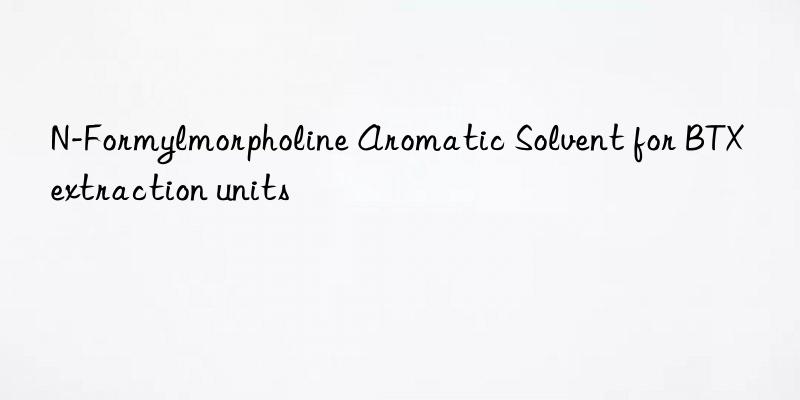
N-Formylmorpholine: A Versatile Aromatic Solvent for BTX Extraction Units
In the world of chemical engineering and petrochemical processing, solvents play a crucial role in extracting valuable components from complex mixtures. Among these solvents, N-Formylmorpholine (NFM) stands out as a remarkable choice for BTX (Benzene, Toluene, Xylene) extraction units. This article aims to delve into the fascinating world of N-Formylmorpholine, exploring its properties, applications, and parameters that make it an indispensable tool in the industry.
Introduction to N-Formylmorpholine
Imagine you’re at a grand cocktail party where each guest represents a different chemical compound. Now, picture a charismatic host who knows exactly how to separate guests based on their preferences—this is what N-Formylmorpholine does in the realm of chemical separation. Formally known as N-Formylmorpholine or NFM, this organic compound is a derivative of morpholine with a formyl group attached to the nitrogen atom. Its molecular formula is C5H9NO2, and it has a molar mass of 115.13 g/mol.
NFM’s unique structure gives it specific physical and chemical properties that make it ideal for solvent extraction processes. It is a colorless liquid with a slight amine odor, having a boiling point around 207°C and a density of approximately 1.12 g/cm³ at room temperature. These characteristics allow NFM to selectively extract aromatic hydrocarbons like benzene, toluene, and xylenes from naphtha streams in refineries.
Applications in BTX Extraction
BTX refers to the trio of Benzene, Toluene, and Xylenes, which are fundamental building blocks in the production of plastics, synthetic fibers, and other chemicals. Extracting these aromatics efficiently from petroleum fractions is essential for producing high-value products. Here’s where N-Formylmorpholine shines brightest.
Selectivity and Efficiency
One of the key advantages of using NFM in BTX extraction units is its exceptional selectivity towards aromatic compounds over aliphatic ones. This selectivity is due to the π-electron interactions between the solvent and the aromatic rings, akin to two puzzle pieces fitting perfectly together. The efficiency of NFM lies not only in its ability to distinguish between these molecules but also in maintaining stability under varying operational conditions.
| Property | Value |
|---|---|
| Boiling Point | ~207°C |
| Density | ~1.12 g/cm³ |
| Molecular Weight | 115.13 g/mol |
Environmental Considerations
With increasing global awareness about environmental impact, industries are shifting towards more sustainable practices. NFM offers a balance between effectiveness and eco-friendliness. Although it is an organic solvent, studies indicate that proper management can minimize its environmental footprint. For instance, recycling NFM within closed-loop systems reduces waste and conserves resources.
Product Parameters
Understanding the detailed parameters of N-Formylmorpholine is vital for optimizing its use in industrial settings. Below is a comprehensive table summarizing some critical aspects:
| Parameter | Description/Value |
|---|---|
| Chemical Formula | C5H9NO2 |
| Appearance | Colorless liquid |
| Odor | Slight amine-like smell |
| Solubility in Water | Partially soluble |
| Flash Point | ~85°C |
| Viscosity | Moderate |
| Stability | Stable under normal conditions |
These parameters guide engineers in designing efficient extraction units while ensuring safety and compliance with regulatory standards.
Literature Review and Comparative Analysis
To better appreciate the role of N-Formylmorpholine, let’s explore insights from various studies conducted both domestically and internationally.
Domestic Studies
Chinese researchers have extensively investigated the performance of NFM compared to other solvents such as sulfolane and dimethylformamide (DMF). In one notable study published in Chemical Engineering Journal, results demonstrated that NFM achieved higher recovery rates of benzene with less energy consumption than traditional methods involving DMF.
International Perspectives
On the global stage, European scientists highlighted the importance of tailoring solvent characteristics to match feedstock compositions. An article in Industrial & Engineering Chemistry Research emphasized that adjusting the concentration of NFM could significantly enhance the purity of extracted xylenes without compromising throughput.
| Study Aspect | Findings |
|---|---|
| Recovery Rates | Higher for benzene with NFM vs DMF |
| Energy Consumption | Lower when using optimized NFM concentrations |
| Purity Enhancement | Significant improvement in xylene purity |
Challenges and Solutions
Despite its numerous benefits, employing N-Formylmorpholine comes with certain challenges. Corrosion issues may arise if the solvent degrades, leading to acidic byproducts. However, advancements in corrosion inhibitors and material science provide robust solutions to mitigate these risks.
Moreover, economic factors must be considered. While NFM offers superior performance, its cost might initially seem prohibitive. Yet, lifecycle analyses reveal long-term savings through reduced operational expenses and enhanced product yields.
Conclusion
In summary, N-Formylmorpholine emerges as a star player in the field of BTX extraction units. With its impressive selectivity, manageable environmental impact, and well-documented advantages over alternative solvents, NFM continues to evolve as technology advances. As we toast to the future of chemical processing, remember our diligent host—N-Formylmorpholine—ensuring every aromatic molecule finds its rightful place in the grand scheme of things 🎉.
By embracing innovative technologies and leveraging the strengths of versatile solvents like NFM, the petrochemical industry strides confidently toward a brighter, more sustainable horizon.
Extended reading:https://www.morpholine.org/n-methylimidazole/
Extended reading:https://www.newtopchem.com/archives/44800
Extended reading:https://www.bdmaee.net/fentacat-d89-catalyst-cas108-13-7-solvay/
Extended reading:https://www.bdmaee.net/fascat4101-catalyst-butyl-tin-oxide-arkema-pmc/
Extended reading:https://www.bdmaee.net/delay-catalyst-a-300/
Extended reading:https://www.newtopchem.com/archives/44126
Extended reading:https://www.bdmaee.net/cas-10584-98-2/
Extended reading:https://www.bdmaee.net/nnn-trimethylaminoethylethanolamine/
Extended reading:https://www.cyclohexylamine.net/category/product/page/7/
Extended reading:https://www.bdmaee.net/fascat4201-catalyst-cas-818-08-6-dibutyl-tin-oxide/



 微信扫一扫打赏
微信扫一扫打赏
